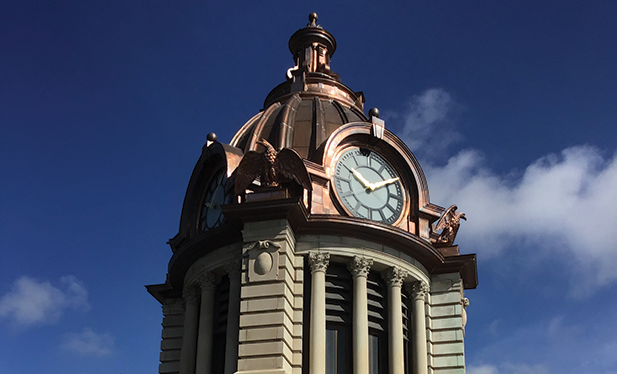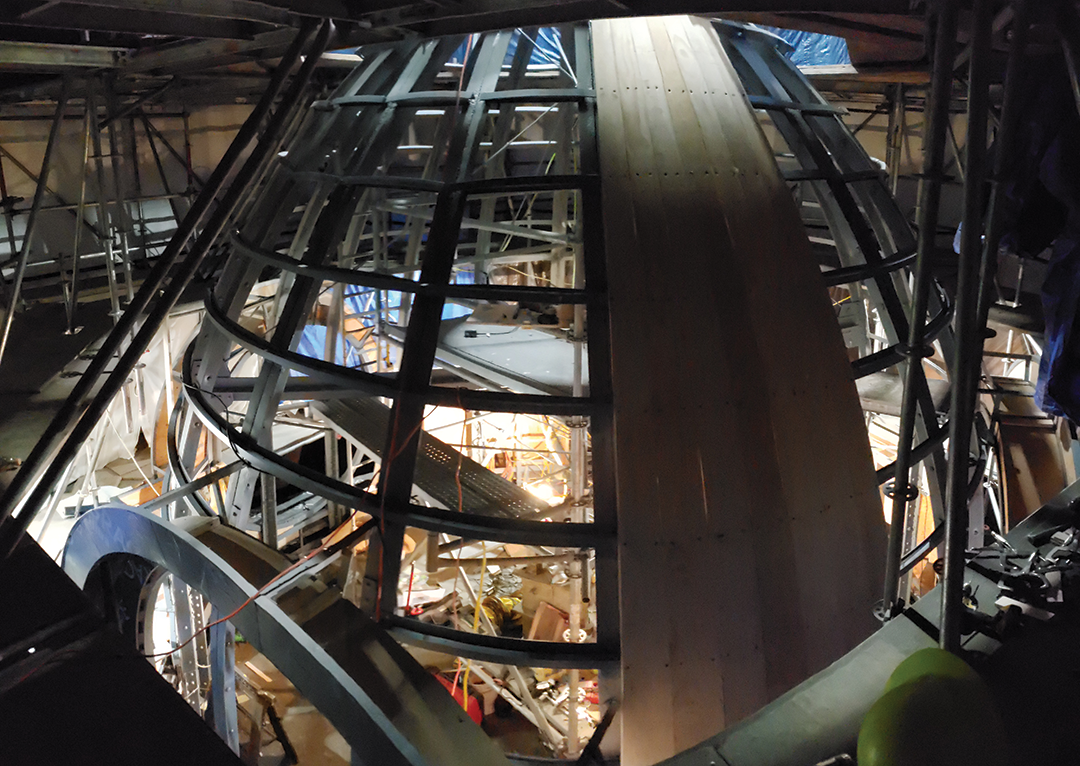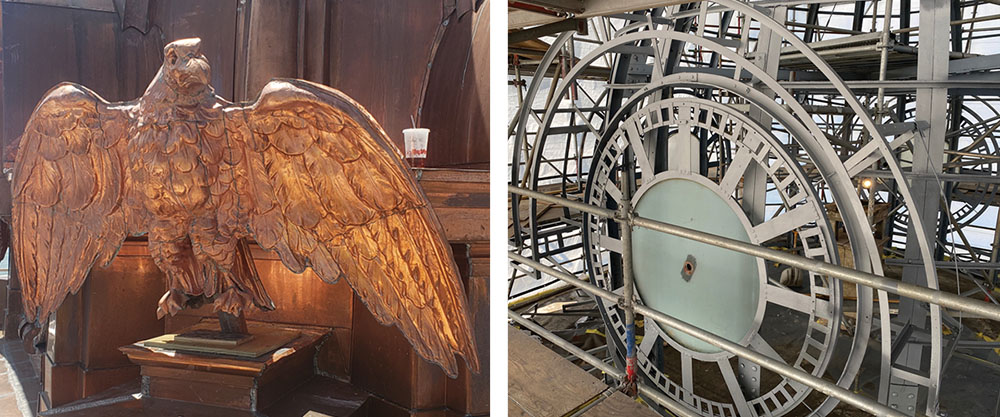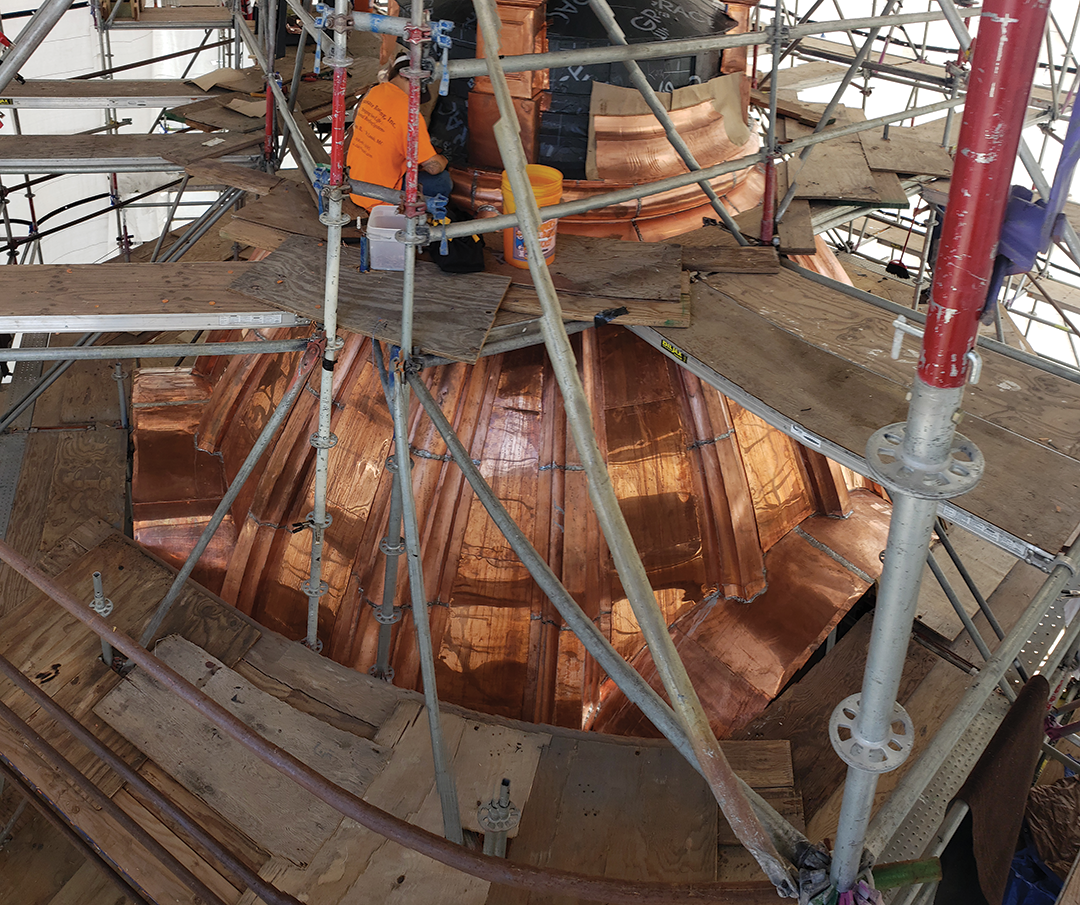
Martin County Courthouse sits atop a hill overlooking Lake Sisseton in Fairmont, Minn. Designed by Charles E. Bell, the three-story Beaux-Arts-style building was built by J.B. Nelson in 1907.
The first floor is made of Marquette sandstone in a reddish hue from Michigan, and the second and third floors are constructed of Bedford limestone from Indiana. The building is topped with a 50-foot-tall copper dome that rests on a 58-foot-high structure with pillars and arches. In 1977, the courthouse was placed on the National Register of Historic Places.
After 113 years of service, the dome began to disintegrate. The steel supports were rusting, and the wood was rotting. In 2020, Renaissance Roofing Inc., Belvidere, Ill., restored the dome before it succumbed to complete deterioration.
Feasibility study
In 2018, ISG, an architecture, engineering, environmental and planning firm headquartered in Mankato, Minn., conducted a feasibility study to assess the copper dome and courthouse roof conditions.
As only minor improvements had been made to the building during its century in service, ISG recommended full dome and roof system replacement. ISG used 3D scanning technology to provide exact details when developing plans for reconstructing a new 20-foot-wide dome and 7,700-square-foot roof system. In addition to plans and specifications, ISG provided project oversight and construction administration for the project.
Copper dome

The Renaissance Roofing team handled on-site roof system tear-off and installation. The dome features four 7-foot-tall glass clockfaces and dials with eagles perched on globes on the corners of the dome structure.
Workers began by removing the existing copper down to the metal substrate. Portions were salvaged and cleaned to create patterns for fabricating new copper pieces.
There was no sheathing under the copper, and its underside had an asbestos coating. The steel structure and multiple dome surfaces also had asbestos coatings, requiring a specialized, dustless, pressurized blasting process. Designated containment areas were set up to ensure safety.
Structural damage from water leaking through holes and cracks in deteriorated copper required replacing half the horizontal structural members.
“The lantern framing and dome’s cornice also were replaced as a result of rust and lack of structural integrity,” says Bob Mickelson, senior project manager for ISG. “Wood sheathing was added to the dome structure to support the new copper roofing. Additional blocking was added under the major dome ribs and other copper details to provide a more durable support that wasn’t present on the original roof. All steel also was primed and painted to offer additional protection.”

Once repairs were complete, the team placed GRACE ULTRA™ self-adhering butyl underlayment over the entire dome and blocking. Because of the large amount of copper soldering required on the dome, PYRO-KURE™ 650 flame-retardant paper was laid over the underlayment and acted as a slip sheet.
All copper on the dome was fabricated and soldered by Renaissance Roofing craftsmen to match historical details. Inside the dome, a mechanical ventilation system was installed to control moisture. Artist Franz Edward Rohrbeck furnished a massive six-piece mural representing the culture of law on the dome’s underside.

Copper eagles
The dome’s four copper eagles were fabricated by Renaissance Roofing craftsmen from two remaining original eagles to match the original statues. The team carefully disassembled the eagles and used about 50 molds to stamp new eagles. Each part needed to be heated and stamped four to five times to avoid tearing the copper sheets. Each of the eagles has a wingspan of about 6 feet.
“We also added new trims and flashing to ensure watertightness and improve expansion capabilities of the copper roofing,” Mickelson says. “Careful attention was given to maintaining the extensive, historically significant details in the copper work of the dome and eagles.”
The original clock and clock dials were restored by Rory DeMasy at Mechanical Watch Supply, Minneapolis.
Safety
An extensive scaffolding system and schedule were key safety precautions used throughout the project. After significant dome restoration was completed in 2021, scaffolding around the dome was removed and reinstalled around the rest of the building to allow safe access to the courthouse’s main roof. Scaffolding included doorways for building access to keep occupants safe.
“Keeping the building operational and accessible was accomplished with careful design of the scaffolding around facility entrances,” Mickelson explains. “While working in winter weather conditions, the dome and scaffolding were enclosed to ensure watertightness.”
Main roof
Work on Martin County Courthouse’s main roof began in September 2021. The original copper on this roof was attached directly to a concrete deck.
“The original standing-seam copper panels had been flattened and a mineral-coated, rolled roofing was installed on top,” Mickelson says. “The roof cement used for the rolled roofing contained asbestos. All the copper and rolled roofing had to be completely abated.”
When workers removed the copper from the main roof, the original gutter system was discovered.
“We fabricated a new gutter system using modern fabrication techniques and materials to provide a more robust drainage system,” Mickelson says.
Renaissance Roofing craftsmen fabricated and installed all the standing-seam copper for the main roof. Because of limited access around the courthouse, the craftsmen lifted materials into place by crane.
The condition of the concrete roof deck was a challenge as it had crumbled in some areas because of freeze-thaw cycles. The team added an adjustable furring system to attach plywood sheathing before applying GRACE ULTRA self-adhering butyl underlayment.
In addition to the roof deck, the parapets also were found to be in poor condition. The team carefully removed the existing parapets and limestone, rebuilt new parapet walls from concrete masonry units and reinstalled the original limestone.
The utmost upper portions of the roof were of such minimal slope, it would have been difficult for copper to remain watertight. HVAC units in those areas also require regular servicing, so the teams used FiberTite® ELVALOY™ KEE membrane as it is better suited for the low slope and occasional foot traffic.
The membrane’s terracotta color matches the newly installed copper roofing for a seamless aesthetic appearance.
Another century
In November 2022, Renaissance Roofing completed work on Martin County Courthouse’s $2.5 million renovation project. Although the project took longer than anticipated because of construction complexities discovered when the original roofing materials were removed, the courthouse was successfully restored to its original appearance and improved using modern construction techniques.
Thanks to dedicated teams at ISG and Renaissance Roofing who diligently worked to renovate the landmark, the courthouse stands ready to serve future generations.
“Being instrumental to the successful restoration of this historic property and working with the professionals at Martin County and ISG was truly rewarding,” says Lon Gorsch, project manager and sheet metal specialist for Renaissance Roofing.
Project name: Martin County Courthouse
Project location: Fairmont, Minn.
Project duration: July 2020-December 2022
Roofing contractor: Renaissance Roofing Inc., Belvidere, Ill.
Roof system types: Copper and KEE membrane
Roofing manufacturers: FiberTite® Roofing Systems Seaman Corp., Wooster, Ohio; GCP Applied Technologies Inc., New Haven, Conn.; Revere Copper Products Inc., Rome, N.Y.
CHRYSTINE ELLE HANUS is Professional Roofing’s associate editor and an NRCA director of communications.


